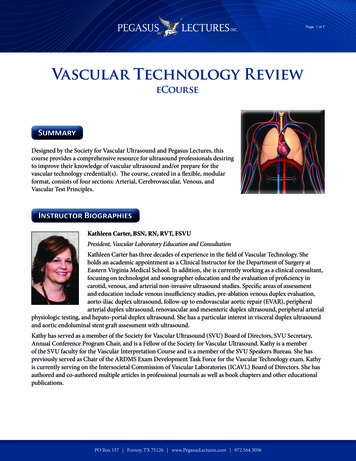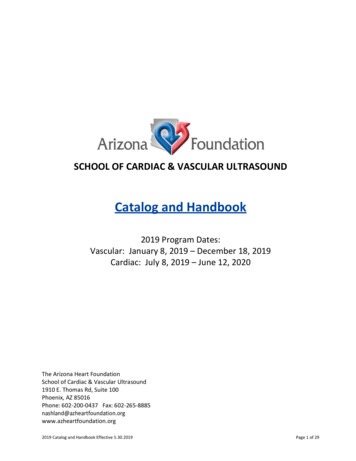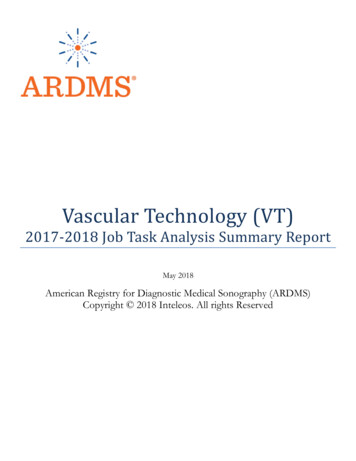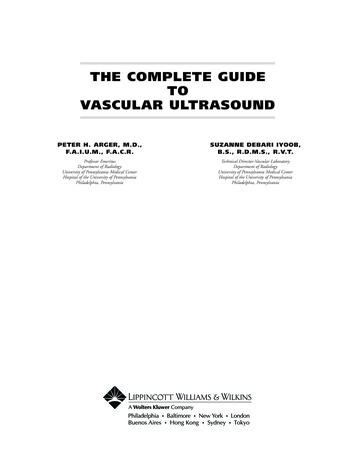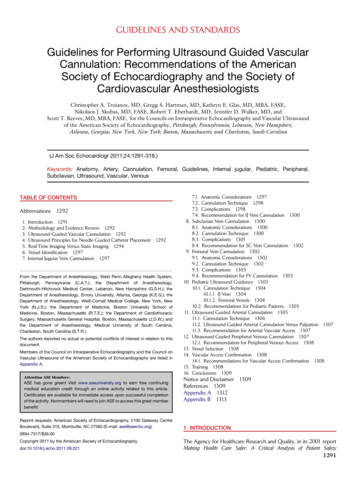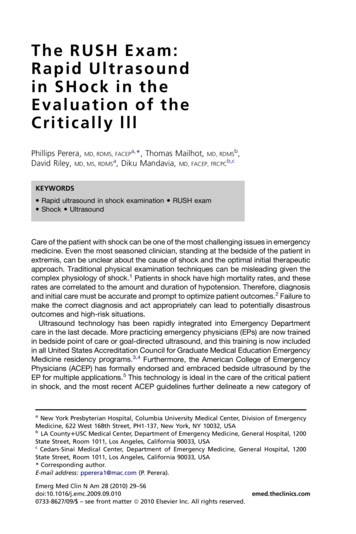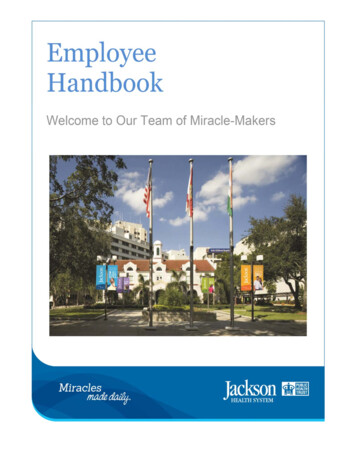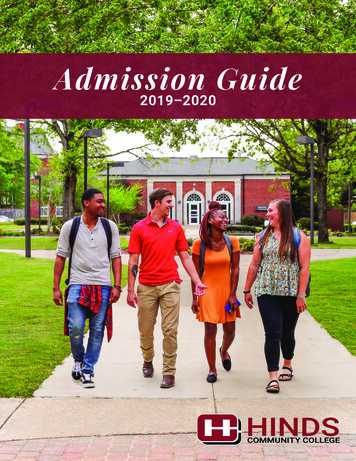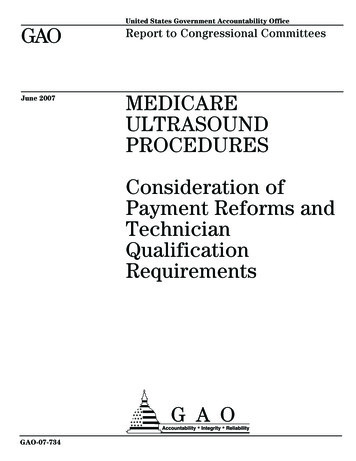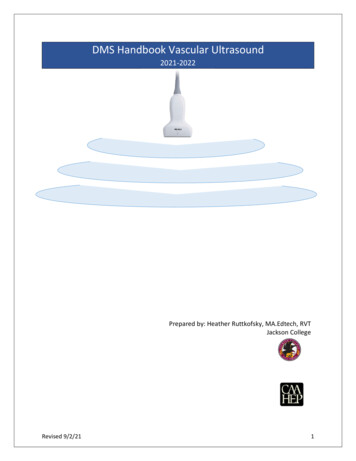
Transcription
DMS Handbook Vascular Ultrasound2021-2022Prepared by: Heather Ruttkofsky, MA.Edtech, RVTJackson CollegeRevised 9/2/211
ContentProgram Director MessageOrganization and Department OverviewVascular Technologist DescribedAccommodations for Students with DisabilitiesProgram SequenceClinical & Lab Policies and GuidelinesHealth Records and PoliciesAcademic Policies and GuidelinesClinical AssessmentPerformance Notice ProcedureProgram DismalRe-Admission to Sonography ProgramExhibits A-HAcknowledgement FormRevised 9/2/212
Program Director MessageDear Student,Thank you for making Jackson College a part of your educational journey; we are honored to have youjoin our team and later join fellow Alumni across the nation! You are beginning your trip when thehealthcare system is undergoing significant changes. Specifically, a practicing sonographer must holdcredentials for the specific performed exams. The Jackson College Vascular Technologist student willwork closely with the vascular surgery team within a vascular service line. Technological advances havechanged the practice in ways we never imagined. The vascular technologist of today and the future musthave good communication, mathematical, scientific, and technological skills to make responsible andethical clinical judgments, apply the sonographic reasoning process and evaluate the effectiveness ofinformation gathered.The program is student-centered. As with anything created for student success, I welcome feedback.Please feel free to offer feedback for improvement in assessment and instructional material.Sincerely,Heather Ruttkofsky, MA, RVTDean of Health Sciences, Career and Technical TradesProgram Director, Vascular TechnologyJackson College2111 Emmons RoadJackson, Michigan 49201c: 517-260-4810e: ruttkofheatherm@jccmi.eduw: www.jccmi.eduVascular Sonography Program AccreditationThe Vascular Sonography Program is accredited by the Commission on Accreditation of Allied HealthEducation Programs (www.caahep.org) upon the recommendation of the Joint Review Committee onEducation in Diagnostic Medical Sonography (www.jrcdms.org).Commission on Accreditation of Allied Health Education Programs9355 – 113th St. N, #7709Seminole, FL 33775Phone: 727.210.2350Fax: 727.210.2354www.caahep.orgRevised 9/2/213
Organizational and Department OverviewJackson College Vascular Technology ProgramThe VSON program is an integrated on-line course study and clinical training program designed toprepare the student for employment in vascular technology. After successful completion of thenationally recognized ARDMS registry exam, the graduate will be eligible to write the initials of RVS orRVT behind his/her name.The Jackson College vascular ultrasound program goal is to prepare competent entry-level vascularsonographers in the cognitive (knowledge), psychomotor (skills), and affective (behavior) learningdomains. Quality and accurate care for every patient is achieved with integrity, reasoning, collaboration,and lifelong learning.Program Learning Goal- Cognitive-Sonographic Reasoning CompetencyThe graduate will be able to think critically and act responsibly.Student Learning Outcome1. Use an investigative approach todetermine the clinical hypothesis andselect the correct exam protocols forimage acquisition.2. Gather, analyze sonographic data,and identify connections to thepathological and clinical findings3. Formulate an accurate diagnosticpreliminary report based on ultrasoundand clinical findingsProgram Learning Goal- Affective -Professionalism CompetencyThe graduate will be able to work productively with others and recognize individual contributions togroup success.Student Learning Outcome1. Participate in quality managementteam work to provide quality patientcare, self-care, and integrity.2. An active member of a professionalorganizations and their community3. Caring advocate and effectivecommunicator among patients ofcultural diversity, normal and alteredstates, and other healthcare teammembers.Program Learning Goal- Psychomotor- Scanning CompetencyThe graduate will be able to show sonographic technological literacy.Revised 9/2/214
Student Learning Outcome1. Exhibit clinical competency in theperformance of vascular exams2. Perform vascular sonographyprocedures appropriately andaccurately recording all anatomic andphysiologic information forinterpretation by a physician3. Application of ultrasound principlesand instrumentation relative to imagingand image quality to produce diagnosticvascular sonography examinationsCompetency Performance StandardsDemonstrate knowledge and application of ergonomic techniqueDemonstrate knowledge and application of types and methods of infection control.Demonstrate knowledge and application of patient careDemonstrate knowledge of the roles and responsibilities of healthcare professions to effectivelycommunicate and collaborate in the healthcare environment.Demonstrate knowledge of medical ethics and lawDemonstrate knowledge of medical and sonographic terminologyObtain, evaluate, document, and communicate relevant information related to sonographicexaminationsIdentify and evaluate anatomic structuresDemonstrate knowledge of disease processes with application to sonographic and Doppler patternsDemonstrate knowledge and application of image production and optimization.Demonstrate knowledge and application of biological effectsRevised 9/2/215
Demonstrate knowledge of a quality control and improvement program.Demonstrate awareness of resources for professional development.Demonstrate achievement of clinical competency through the performance of the requirements toprovide quality patient care and optimal examination outcome.Demonstrate knowledge of anatomy and anatomic variants of the cardiovascular system.Demonstrate knowledge of normal and abnormal peripheral vascular physiology and hemodynamicsDemonstrate knowledge of mechanisms of vascular diseases, vascular pathophysiology, andhemodynamic effects.Demonstrate knowledge of sonographic appearances, sonographic techniques, measurements, andDoppler characteristics in both normal and abnormal vascular structuresDemonstrate knowledge of physiologic vascular testing principles and techniques.Demonstrate knowledge and application in the use of quantitative principles applied to vasculartesting.Demonstrate knowledge in ultrasound-guided proceduresDemonstrate knowledge of the role of ultrasound for evaluation of vascular surgical procedures orinterventions, including a role in planning, intra-procedural guidance/technical evaluation, and/or postprocedure assessmentEvaluate scanning protocol and modification(s) based on patient-specific factorsDemonstrate knowledge and application of quality assurance and statistical tests used in a vascularlaboratoryDemonstrate achievement of clinical competency through the performance of sonographicexaminations of the vascular system according to practice parameters established by nationalprofessional organizations and the protocol of the clinical affiliate.Revised 9/2/216
Jackson CollegeMissionTogether we inspire and transform livesVisionJackson College is a world-class institution ofhigher education, where learners succeed, andcommunity needs are metJackson College Department of VascularTechnologyMissionTo be leaders in collaboration with state andnational stakeholders in preparing competent,life-long learners who contribute to advancing thevascular technology profession.VisionTo prepare talented, competenttechnologists to enter the workforce to provideexcellence in patient care and high-qualityvascular exams across the spectrum.Jackson College and Department of Vascular TechnologyIntegrity – We demonstrate integrity through professional, ethical, transparent, and consistentbehavior in both our decision-making and in our treatment of people; being accountable for ourwork and actions is the basis of trust.Caring – We demonstrate caring through attentive and responsive action to the needs of students,employees and our community. We listen with open minds, speak kindly, and foster relationshipsbased on mutual respect and trust.Collaboration – We demonstrate collaboration through the mutual commitment of individualsand organizations who come together for a common cause.Innovation – We demonstrate innovation through the continuous improvement of all processesand services.Equity – We demonstrate equity by seeking involvement and providing access for those withdiverse backgrounds to work toward a culture of inclusion while maintaining differences in arespectful way.Service – We demonstrate service by striving to make the communities we serve great places tolive, work, and learn.Leadership – We demonstrate leadership by nurturing the full development of our employees andthose we serve.Stewardship – We demonstrate stewardship through our mindful management of the human,intellectual, fiscal and environmental resources entrusted to us.Revised 9/2/217
Program Administration and FacultyContactDr. Daniel J PhelanPresident and CEOPhelanDanielJ@jccmi.eduHeather Ruttkofsky, MA,RVTDean of Nursing and Allied 517-260-4810Healthruttkofheatherm@jccmi.eduDr. Jordan KnepperProgram Medical Advisorjkneppe1@hfhs.orgHeather Ruttkofsky, MA,RVTProgram Director517-260-4810ruttkofheatherm@jccmi.eduShani Lebaron , BS, RVTClinical CoordinatorLeBaronShaniD@JCCMI.EDUJessica Hagerty, RVSInstructorHagertyJessicaL@jccmi.eduCandy Nighswander, RVTInstructorNighswaCandasR@JCCMI.EDUNikki Lenart, RVT, RDCSInstructorLenartNicoleR@jccmi.eduPatricia Poe, RVT, RDCSInstructorpoepatricia@jccmi.eduBrad iption of the ProfessionDiagnostic medical sonography (DMS) is a multi-specialty occupation comprised of abdominal-extendedsonography, adult cardiac sonography, breast sonography, musculoskeletal sonography, obstetrics andgynecology sonography, pediatric cardiac sonography, vascular sonography, and other emerging clinicalareas or concentrations.These concentrations all use comprehensive knowledge of ultrasound technology in their daily work. Thetrained technologist is an individual who provide s patient care services applying ultrasound technologyin the performance of diagnostic and/or therapeutic exams and procedures. As an occupationalprerequisite the diagnostic medical sonographer must be educationally prepared and clinicallycompetent. Demonstration and maintenance of competency through certification by a nationallyrecognized credentialing organization is the standard of practice in sonography. Maintenance ofcertification in all areas of practice is endorsed.Revised 9/2/218
The diagnostic medical sonographer functions as a delegated agent of the physician and does notpractice independently. Diagnostic medical sonographers are committed to enhanced patient care andcontinuous quality improvement that increases knowledge and technical competence. Diagnosticmedical sonographers use independent, professional and ethical judgment, and critical thinking to safelyperform diagnostic procedures.The diagnostic medical sonographer generally performs the following: Obtains, reviews, and integrates pertinent patient history and supporting clinical data tofacilitate optimum diagnostic results; Performs appropriate procedures and records anatomic, pathologic, and/or physiologic data for interpretation by a physician; Records, analyzes, and processes diagnostic data and other pertinent observations made during the procedure for presentation to the interpreting physician; Exercises discretion and judgment in the performance of sonographic and/or related diagnostic services; Demonstrates appropriate communication skills with patients and colleagues; Acts in a professional and ethical manner; Facilitates communication and education to elicit patient cooperation and understanding of expectations and responds to questions regarding the sonographic examination.As a multi-specialty occupation, these Standards apply to the following learning concentrations:Abdominal Extended SonographyAdult Cardiac SonographyBreast SonographyMusculoskeletal SonographyObstetrics and Gynecology SonographyPediatric Cardiac SonographyVascular SonographyVascular TechnologistVascular sonographer is a highly skilled allied health professional who performs arterial and venousdiagnostic procedures using high frequency sound waves. A vascular sonographer operates a variety ofcomplex diagnostic and monitoring equipment, as well as numerous ancillary devices.The vascular sonographer performs carotid duplex scanning, lower and upper extremity Dopplerexaminations, venous duplex scans, abdominal vascular exams, evaluates test results, monitorsphysiological states of the patient, conducts patient education, and maintains accurate records andprotocols during and after procedures. A thorough understanding of hemodynamics andpathophysiology is required.Obtain, review, and integrate pertinent patient history and supporting clinical data to facilitate optimumdiagnostic results. Perform appropriate procedures and record anatomical, pathological and/or physiological data forinterpretation by a physician.Revised 9/2/219
Record and process sonographic data and other pertinent observations made during theprocedure for presentation to the interpreting physician. Exercise discretion and judgment in the performance of sonographic services. Provide patient education related to medical ultrasound. Promote principles of good health.Accommodations for Students with Disabilities:ProgramIf a student has a documented learning disability, visual or hearing impairment, psychiatric issue, orother physical or psychological challenge that interferes with learning, the Center for Student Success(CSS) can arrange accommodations for each student’s classes in compliance with the AmericanDisabilities Act. Based on the student’s particular needs, accommodations may include but are notlimited to: Extended testing time Quiet testing location Assistive technology Note takers Alternative text formats Sign language interpreter It is the student’s responsibility to self-disclose a disability.Once documentation has been provided, CSS can arrange accommodations with instructors eachsemester. It is the student’s responsibility to self-disclose a disability. Once documentation has beenprovided, CSS can arrange accommodations with instructors each semester.Center for Student Success Accommodations for Students with DisabilitiesSAmerican Registry for Diagnostic Medical SonographyAmerican Registry for Diagnostic Medical Sonography (ARDMS) provides reasonable testingaccommodations in compliance with the Americans with Disabilities Act (ADA). Under the ADA, adisability is a physical or mental impairment that substantially limits one or more major life activities.Having a diagnosed impairment does not necessarily mean that an individual is disabled as defined bythe ADA, and not all disabilities require test accommodations.Test accommodations are adjustments or modifications of standard testing conditions designed to allowcandidates with disabilities to take the examination without compromising its validity, providing anunfair advantage to disabled candidates or imposing undue burdens on ARDMS.If you are an Applicant seeking accommodation, you must submit, along with your completedapplication:1. An original letter, dated within the past five years and typed on official letterhead, from aqualified physician or health provider who specializes in the disability. This letter must documentRevised 9/2/2110
the disability and its severity, describe the applicant’s limitation due to the disability, and stateexactly what accommodations are recommended. The letter must contain an original signatureand the physician’s or health professional’s credentials;2. An original, current, detailed, comprehensive medical evaluation/ report of the diagnoseddisability from the physician or health professional, dated within the past five years; and3. A completed ARDMS Special Accommodations Questionnaire which must be submitted eachtime you apply for examination.Review of applications containing a request to receive ADA accommodations may require anadditional 30 days to be completed.Documentation submitted by an applicant in support of a request is reviewed by ARDMS and may beforwarded to an independent medical expert for impartial professional review.ARDMS may request additional documentation to support the request. All information will be keptconfidential and will be used only to determine what, if any, test accommodations will be made.Approved accommodations will be included in the Examination Confirmation Letter, sent to you viaemail and also available through MY ARDMS account, under “My Examinations/Application Status”found under the “Application Center” tab. The email will include the test vendor’s telephone numberand you should call the test vendor to schedule an examination appointment with the approvedaccommodations.Note: All supporting documentation must be received before processing. Incomplete or illegibleapplications or questionnaires may be refunded, minus the non-refundable examination processing feeper examination.Laboratory Skill AssessmentsExtended time for live demonstration skills examinations: The purpose of skills test items incorporatesthe designated response time for patient safety and provider efficiency in the clinical setting. Studentswho are granted accommodations through the Center for Student Success (CSS) can complete any skillsnon-final practicum examination with up to 1.5 minutes per image acquisition (standard time is oneminute per image acquisition). For clinical purposes, no extensions to established times are allowed.Jackson College follows the times set forth by the clinical site department policies. (See Center forStudent Success Accommodations for Students with Disabilities)Revised 9/2/2111
Program SequenceVascular education builds on prior learning. It is necessary to complete certain required courses beforetaking advanced courses. The following courses must be completed in sequence with a 2.0 grade beforeproceeding to the next more advanced course.All DMS clinical courses are subject to special scheduling dates which may or may not follow the collegesemester dates and/or the college calendar.Vascular TechnologySemester SUMSemester SUMCourse NameCreditsBCHSemester 1 (spring)DMS 102Vascular Anatomy, Physiology andPathophysiology33DMS 103Introduction to SonographicReasoning and Research22Basic Cardiovascular Principles,Hemodynamics and DopplerWaveforms3388Introduction Vascular Technologyand Professional lab Practice105 hours lab practice37DMS 205Arterial Duplex and PhysiologicImaging33DMS 161Clinical 24 hours each week x 14weeks48Venous Duplex Imaging331321DMS 202Semester 1 TotalsSemester A 8/30- Semester B 10/410/112/18Semester 2 (Fall)DMS 160DMS 205DMS 203Semester 2 TotalsSemester ASemester BSemester 3 (Winter)Revised 9/2/2112
DMS 206DMS 206Sonographic Physics44Cerebrovascular Imaging(intracranial and extracranial)33Clinical II24 hours x 15481115Advanced Imaging (abdominal,post-operative procedures)33DMS209Capstone44DMS 266Clinical III 24 hours x 13 weeks471114DMS 207DMS 265DMS 265Semester 3 TotalsSemester ASemester BSemester 4 (Spring)DMS 208DMS 266Semester 4 TotalsClinical Total 1000 flexiblecompletionCourse DescriptionJackson College’s Vascular Ultrasound Program is designed as an outcome-based program. Students whodemonstrate entry-level skills and program goals are eligible for early completion during the final clinicalsemester. Each student has maximum of 1,000 hours to achieve clinical goals.DMS 102 Vascular Anatomy, Physiology and PathophysiologyIn this course students are introduced to the anatomy of the venous, arterial, microcirculation, andanatomic variants of the body. The abdominal structures associated with the vasculature will also beexplored. In this course students are introduced to normal function of the venous and arterial systems,abnormal mechanisms, risk factors, and indications of arterial and venous disease associated with arange of pathological conditions.DMS 103 Introduction to Sonographic Reasoning and ResearchIn this course students are introduced to the sonographic reasoning method framework, founded bySteven M. Penny, MA, RT(R), RDMS and Anna Zachariason, BS. Using the analytical framework studentswill be provided a fundamental approach to critical thinking and problem solving associated withvascular ultrasound examinations. This course explores basic research steps and the importance ofcontributing to sonography education and becoming lifelong learners. Students will become members ofthe Society of Vascular Ultrasound and begin exploring the process for writing abstracts and journalarticles.Revised 9/2/2113
DMS 160 Introduction Vascular Technology and Professional lab PracticeIn this course students are introduced to and practice the Intercostal Accreditation Commission (IAC)exam testing protocols of the venous duplex obstruction testing, carotid duplex testing (including manualblood pressure measurements) and ABI exam. The routines of the daily lab are simulated using variousIn-patient scenarios and outpatient scenarios. Students practice oral communication in a concise, clearand effective manor with students, faculty, and staff. Students actively explore ultrasound equipmentand scanning techniques. The appropriate use of color, pulse-wave Doppler, and gray-scale settings isapplied to obtain optimal images and Doppler waveform patterns. Students are assessed for properergonomics while manipulating the transducer and scanning in the transverse to sagittal scan plans.HIPPA, OSHA Universal Precautions, and basic patient transfer techniques are covered and assessed. Theaffective, cognitive and psychomotor skills are also assessed in this course.DMS 202 Basic Cardiovascular Principles, Hemodynamics and Doppler WaveformsIn this course students are introduced to math equations and the relationship of variables to the physicsof normal and abnormal blood flow patterns. Basic fluid properties of the venous and arterial systemsare defined. The Doppler effect and color Doppler imaging are also introduced in this course. The use ofthe Doppler equation is used to show how the Doppler spectrum is formed. Measurements of theDoppler waveform are covered and artifacts that may occur are explained.DMS 203 Venous Duplex TestingIn this course theories, techniques and venous testing procedures of the lower and upper extremityexams are covered. Other topics will include: differential diagnosis; other imaging modalities; identifyingdeep vein thrombosis; advanced exploration of venous anatomy and collateral pathways; pathology &pathophysiology; Color Doppler & PW Doppler waveforms techniques & principles; preliminarywriting. Assessment of these skills will occur in this didactic course and applied in the clinical coursework.DMS 205 Arterial Duplex and Physiologic ImagingIn this course theories, techniques and arterial testing procedures of the lower and upperextremity duplex and physiological exams are covered. Other topics will include: bypass graft imaging;differential diagnosis; other imaging modalities; advanced exploration of arterial anatomy & collateralpathways; pathology & pathophysiology; techniques & principles of color, PW, CW Doppler waveforms;preliminary writing. Assessment of these skills will occur in this didactic course and applied in the clinicalcourse work.DMS 207 Cerebrovascular Procedures (extracranial and intracranial)In this course theories, techniques and testing procedures (imaging and non-imaging) of the extracranialand intracranial exams are covered. Topics will include: differential diagnosis; other imaging modalities;tests of accuracy; advanced exploration of arterial anatomy; collateral pathways; pathology &pathophysiology; techniques & principles of color & PW Doppler waveforms; preliminarywriting. Assessment of these skills will occur in this didactic course and applied in the clinical coursework.Revised 9/2/2114
DMS 208 Advanced Imaging (abdominal, post-operative procedures)In this course theories, techniques and testing procedures of the abdomen and post-operative exams arecovered. Topics will include: post-operative procedures (abdominal, carotid, lower and upperextremities); abdominal arterial and venous visceral and aortic-iliac arterial disease using duplexultrasound. Advanced exploration of abdominal arterial and venous anatomy, pathology &pathophysiology; Color Doppler, PW Doppler waveforms techniques and principles; preliminary writing.Assessment of these skills will occur in this didactic course and applied in the clinical course work.DMS 209 CapstoneIn this course is a 7-week learning plan designed to immerse students in lessons of how to learn, applyreal-world skills, answer contextual style questions and build a deeper understanding of the arterial andvenous vascular system, disease processes, pathology, and pathophysiology. The full interactivecomprehensive-progressive learning plan is designed for various learning styles and is designed toprepare students for the rigors and endurance needed to complete the registry exam. The content onthis site follows the American Registry of Diagnostic Medical Sonography (ARDMS) application andtesting outlines. A preselected exam date is embedded in the learning plan schedule. Multiple quizzesand a timed computerized, 200 question mock exam are located at the end of the program containingcontextual questions and explanation of incorrect answers.Clinical & Lab Policies and GuidelinesClinical ExperienceIt is expected that student’s high learning curve days of clinical will be on those days when the clinical sitehas a lower-case load. Low learning curve days are when the clinical site is very busy with a heavy caseload. On busy days, the student is expected to be of as much help to the staff as is possible. However, thestudents are placed in a clinical site as a learning modality, and we fully wish to utilize this clinicalexperience possible. Students must understand and adhere to the policies the clinical site requires priorto working in that particular clinical site.CLINICAL SITE ASSIGNMENTA clinical site must be arranged and approved for each applicant before final acceptance/admissions intothe program. New clinical sites requests are due at the time the program application is submitted (March1). Do not initiate independent contact with any current Jackson College clinical sites. The clinical site is athird-party entity into which students are placed for practical experience. The Clinical staff employees arenot paid JC faculty for the clinical education portion of the program. Jackson College cannot guaranteethat a clinical site will always be available. Arrangement for such a site depends upon the college’s abilityto enter into a formal agreement with a proposed site. Students should not rely upon the availability of aclinical site particular geographical location. College uses its best efforts to negotiate clinical sites, evenafter they become available, they can become unavailable for reasons beyond the control of JacksonCollege and in that event Jackson College has no liability.Revised 9/2/2115
Clinical Hour Requirements:The MAXIMUM Clinical Practicum hours for AAS & CERT-Vascular Technology Program is 1,000.Student Work Policy: The clinical component of the program shall be educational in nature. Students maynot substitute or replace paid staff members of the clinical affiliate. Paid employment of a student in aclinical department will not be used in lieu of the time assigned to the structured clinical experience. DMSstudents are NOT allowed to accept financial compensation for any of their clinical site component.Employment, volunteer services or any other activities cannot interfere with clinical rotations or used inlieu of clinical rotations. Students will not be allowed to use employment, volunteer services or any otheractivities as clinical experience.Clinical Assignment: The Jackson College Clinical Coordinator will establish the specific student clinicalassignments and rotation for each clinical site. Students may be expected to commute to an additionalclinical site (other than the initial clinical site assigned to them) to obtain the complete education of thesonography program. The Jackson College Program Coordinator and Clinical Instructors must approve allstudent rotations.A Basic Clinical Site Schedule will be utilized as a guide by the Clinical Coordinator. The clinical educationschedule will be determined by the assigned Clinical Instructor of the clinical site. The DMS students maybe required to follow the workday schedule of their clinical site. Lunches and work breaks will be at thediscretion of the supervising sonographer. Time is not given for a 30 minute lunch, this means that astudent must be at their clinical site for 8.5 hours per day in order to reach their 8 hour minimumrequirement per day. The clinical schedule is determined by the clinical site not the student. Studentsshould contact their instructor if they have a problem with their schedule; however, the clinical site’s needsshall dictate the schedule.Clinical Coordinator: A Jackson College faculty who provides DMS clinical education direction forstudents while at their assigned clinical site.Clinical Instructor: An employee of the assigned clinical site who will support/supervise the clinicaleducation that the Jackson College student is receiving during their clinical education.VSON students are required to follow all rules and regulations of each clinical site they are assigned.Students violating such rules or regulations will be subject to the warning process and/or dismissal fromthe VSON program.It is the student’s responsibility to establish a working relationship with their clinical site. Failure to do sowill resul
The Jackson College vascular ultrasound program goal is to prepare competent entry-level vascular sonographers in the cognitive (knowledge), psychomotor (skills), and affective (behavior) learning domains. Quality and accurate care for every
